Cafe 13: Effective Leadership Styles and Change Management Strategies
VerifiedAdded on 2023/01/09
|9
|2382
|93
Report
AI Summary
This report provides a comprehensive analysis of Cafe 13's change management challenges, focusing on the leadership styles and strategies employed. It examines the difficulties faced by the company in adapting to external environmental changes, leading to high labor turnover. The report explores the application of Kotter's 8-step change model as a planned approach for managing change effectively. It delves into various leadership styles, including behavioral and contingency theories, and suggests relevant business strategies to improve employee motivation, enhance communication, and foster a positive work environment. The report emphasizes the importance of creating a clear vision for change, removing obstacles, and building on short-term wins to ensure the successful implementation and sustainability of changes within Cafe 13. The conclusion highlights the significance of effective leadership and strategic management in driving company growth and adapting to market dynamics.
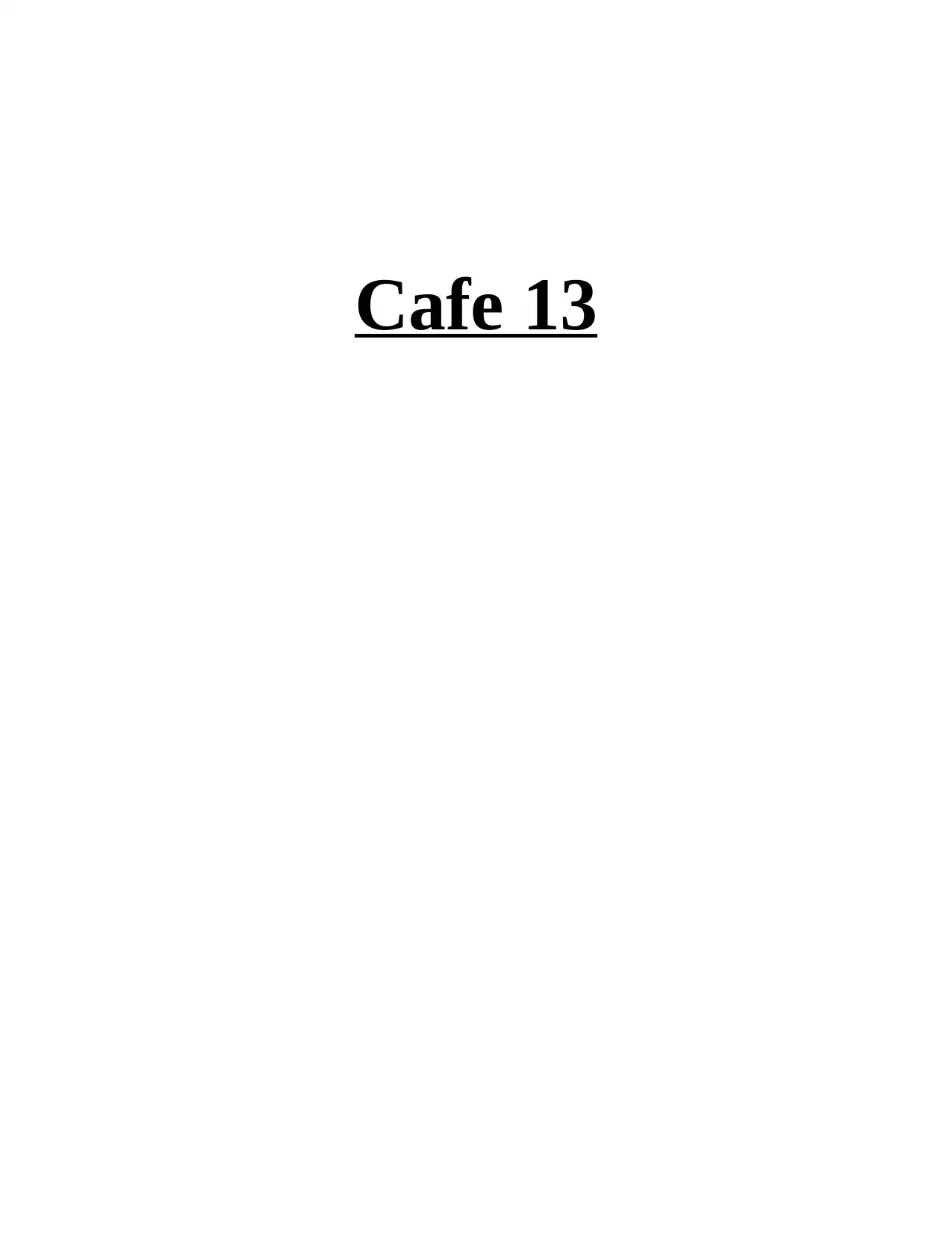
Cafe 13
Paraphrase This Document
Need a fresh take? Get an instant paraphrase of this document with our AI Paraphraser
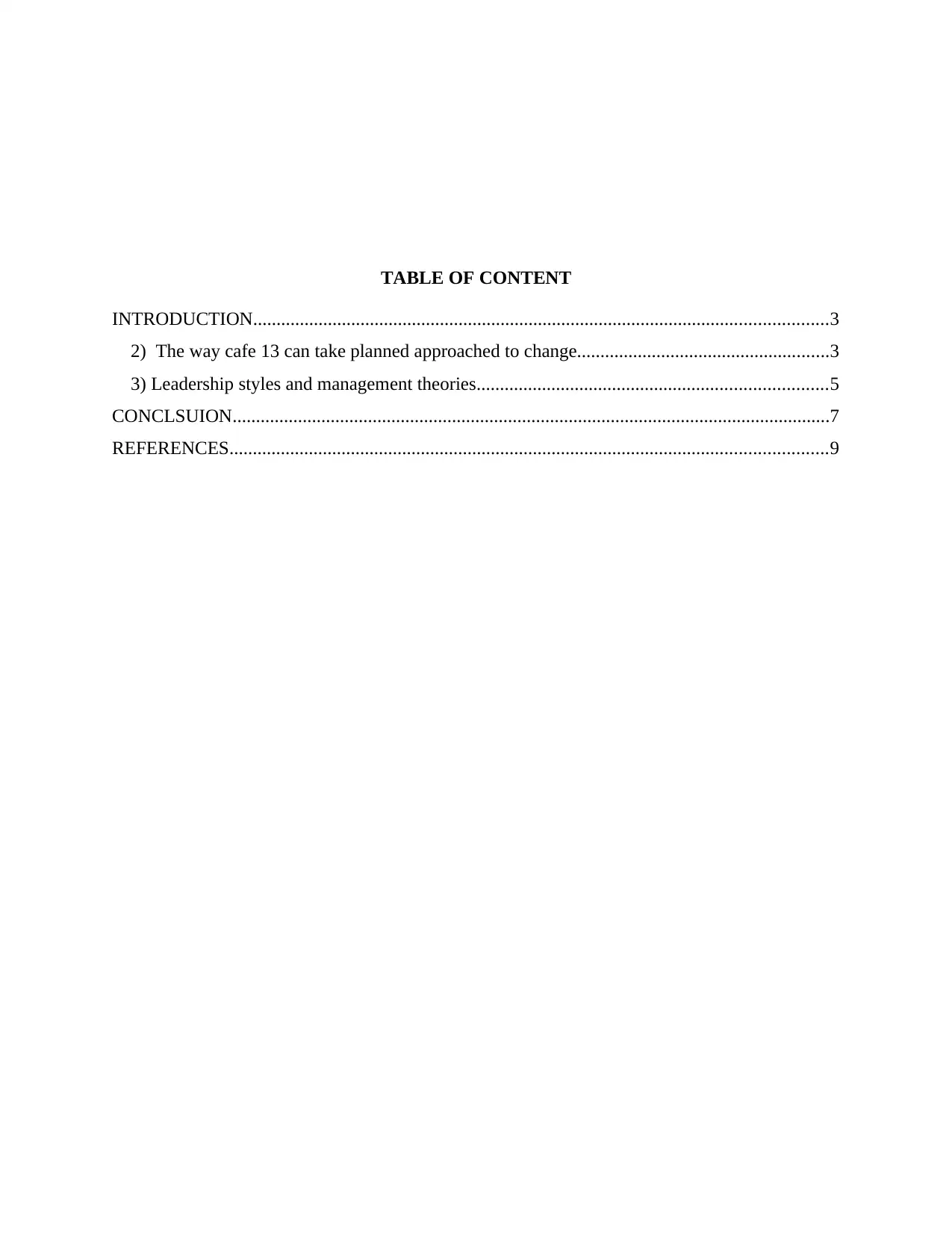
TABLE OF CONTENT
INTRODUCTION...........................................................................................................................3
2) The way cafe 13 can take planned approached to change......................................................3
3) Leadership styles and management theories...........................................................................5
CONCLSUION................................................................................................................................7
REFERENCES................................................................................................................................9
INTRODUCTION...........................................................................................................................3
2) The way cafe 13 can take planned approached to change......................................................3
3) Leadership styles and management theories...........................................................................5
CONCLSUION................................................................................................................................7
REFERENCES................................................................................................................................9
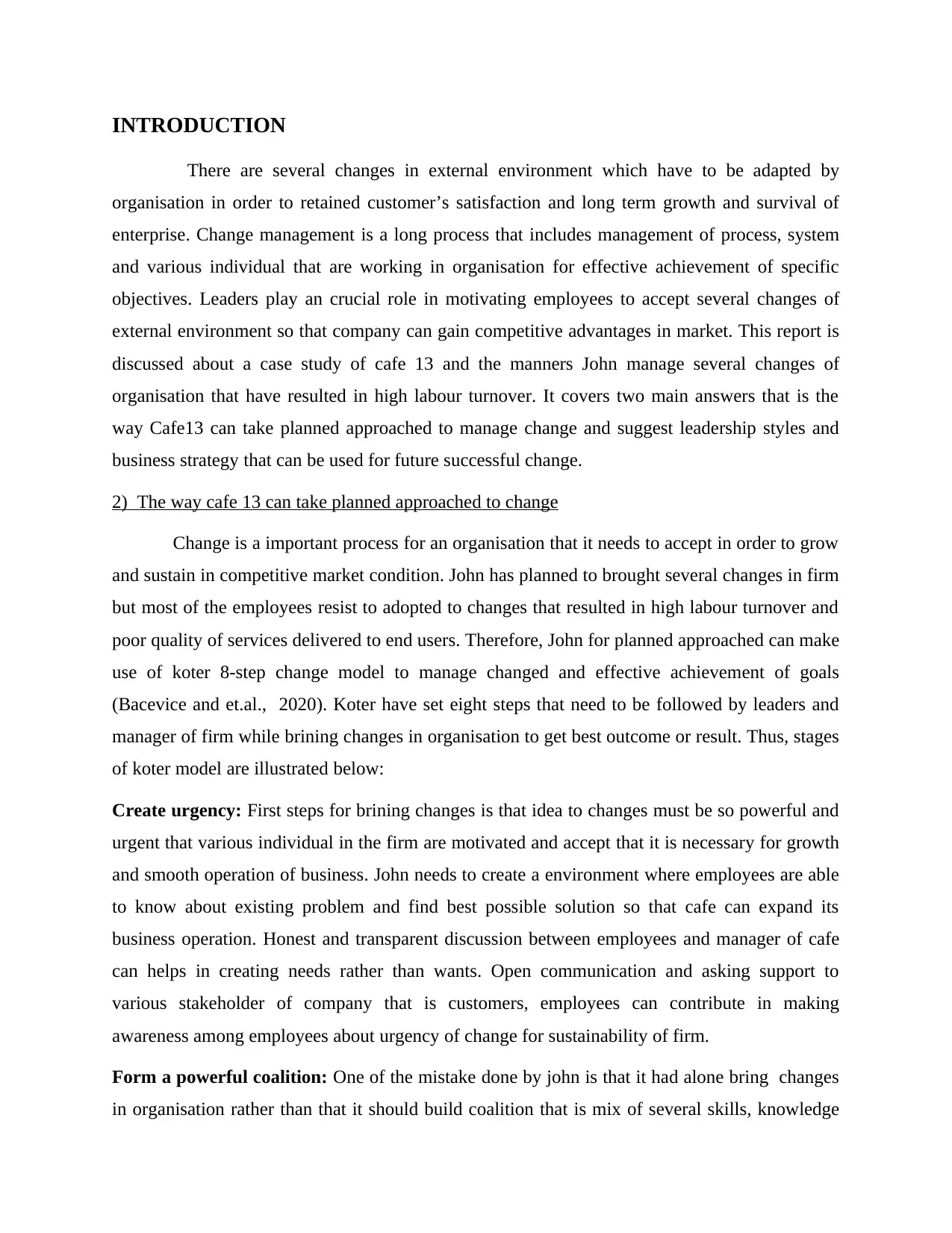
INTRODUCTION
There are several changes in external environment which have to be adapted by
organisation in order to retained customer’s satisfaction and long term growth and survival of
enterprise. Change management is a long process that includes management of process, system
and various individual that are working in organisation for effective achievement of specific
objectives. Leaders play an crucial role in motivating employees to accept several changes of
external environment so that company can gain competitive advantages in market. This report is
discussed about a case study of cafe 13 and the manners John manage several changes of
organisation that have resulted in high labour turnover. It covers two main answers that is the
way Cafe13 can take planned approached to manage change and suggest leadership styles and
business strategy that can be used for future successful change.
2) The way cafe 13 can take planned approached to change
Change is a important process for an organisation that it needs to accept in order to grow
and sustain in competitive market condition. John has planned to brought several changes in firm
but most of the employees resist to adopted to changes that resulted in high labour turnover and
poor quality of services delivered to end users. Therefore, John for planned approached can make
use of koter 8-step change model to manage changed and effective achievement of goals
(Bacevice and et.al., 2020). Koter have set eight steps that need to be followed by leaders and
manager of firm while brining changes in organisation to get best outcome or result. Thus, stages
of koter model are illustrated below:
Create urgency: First steps for brining changes is that idea to changes must be so powerful and
urgent that various individual in the firm are motivated and accept that it is necessary for growth
and smooth operation of business. John needs to create a environment where employees are able
to know about existing problem and find best possible solution so that cafe can expand its
business operation. Honest and transparent discussion between employees and manager of cafe
can helps in creating needs rather than wants. Open communication and asking support to
various stakeholder of company that is customers, employees can contribute in making
awareness among employees about urgency of change for sustainability of firm.
Form a powerful coalition: One of the mistake done by john is that it had alone bring changes
in organisation rather than that it should build coalition that is mix of several skills, knowledge
There are several changes in external environment which have to be adapted by
organisation in order to retained customer’s satisfaction and long term growth and survival of
enterprise. Change management is a long process that includes management of process, system
and various individual that are working in organisation for effective achievement of specific
objectives. Leaders play an crucial role in motivating employees to accept several changes of
external environment so that company can gain competitive advantages in market. This report is
discussed about a case study of cafe 13 and the manners John manage several changes of
organisation that have resulted in high labour turnover. It covers two main answers that is the
way Cafe13 can take planned approached to manage change and suggest leadership styles and
business strategy that can be used for future successful change.
2) The way cafe 13 can take planned approached to change
Change is a important process for an organisation that it needs to accept in order to grow
and sustain in competitive market condition. John has planned to brought several changes in firm
but most of the employees resist to adopted to changes that resulted in high labour turnover and
poor quality of services delivered to end users. Therefore, John for planned approached can make
use of koter 8-step change model to manage changed and effective achievement of goals
(Bacevice and et.al., 2020). Koter have set eight steps that need to be followed by leaders and
manager of firm while brining changes in organisation to get best outcome or result. Thus, stages
of koter model are illustrated below:
Create urgency: First steps for brining changes is that idea to changes must be so powerful and
urgent that various individual in the firm are motivated and accept that it is necessary for growth
and smooth operation of business. John needs to create a environment where employees are able
to know about existing problem and find best possible solution so that cafe can expand its
business operation. Honest and transparent discussion between employees and manager of cafe
can helps in creating needs rather than wants. Open communication and asking support to
various stakeholder of company that is customers, employees can contribute in making
awareness among employees about urgency of change for sustainability of firm.
Form a powerful coalition: One of the mistake done by john is that it had alone bring changes
in organisation rather than that it should build coalition that is mix of several skills, knowledge
⊘ This is a preview!⊘
Do you want full access?
Subscribe today to unlock all pages.

Trusted by 1+ million students worldwide
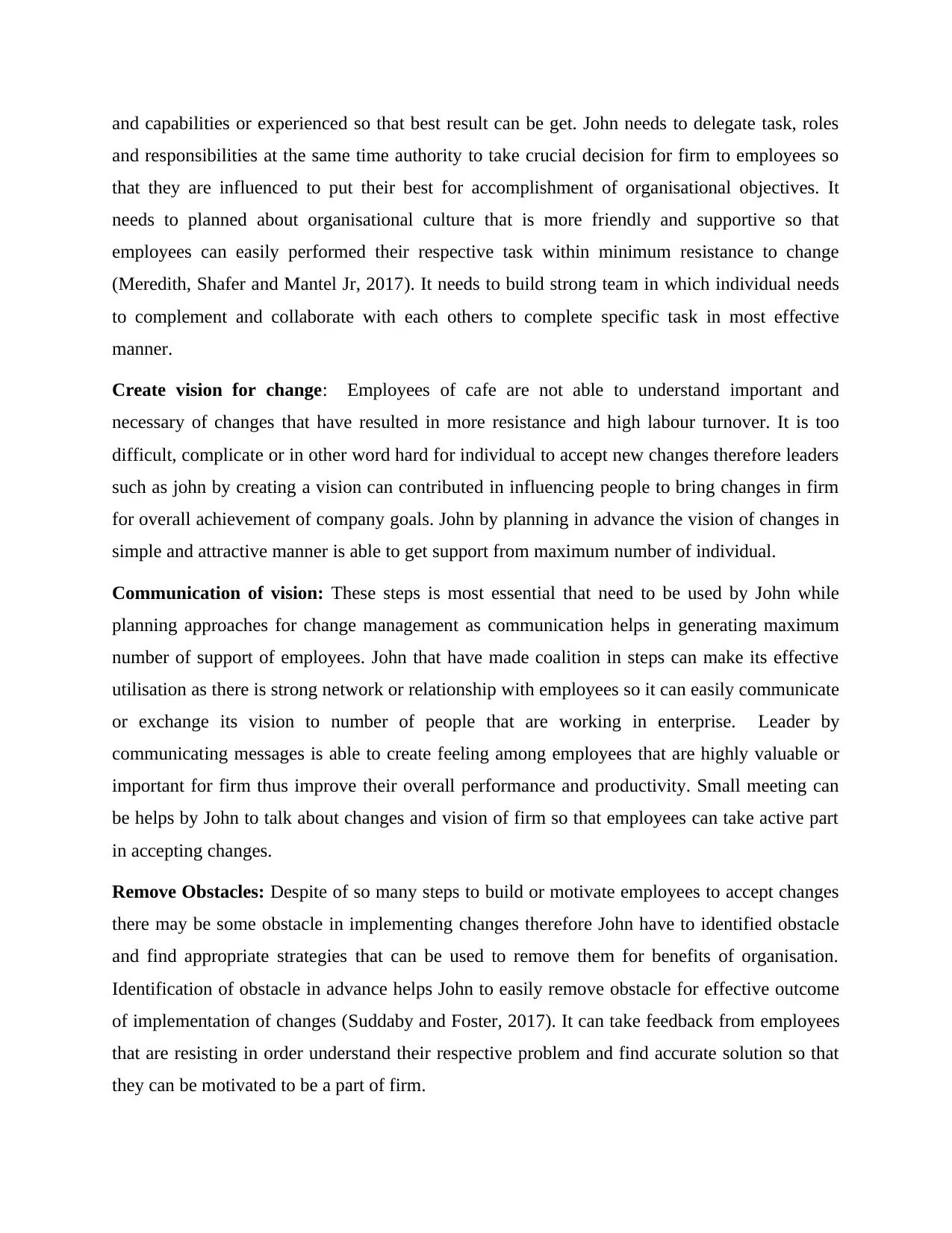
and capabilities or experienced so that best result can be get. John needs to delegate task, roles
and responsibilities at the same time authority to take crucial decision for firm to employees so
that they are influenced to put their best for accomplishment of organisational objectives. It
needs to planned about organisational culture that is more friendly and supportive so that
employees can easily performed their respective task within minimum resistance to change
(Meredith, Shafer and Mantel Jr, 2017). It needs to build strong team in which individual needs
to complement and collaborate with each others to complete specific task in most effective
manner.
Create vision for change: Employees of cafe are not able to understand important and
necessary of changes that have resulted in more resistance and high labour turnover. It is too
difficult, complicate or in other word hard for individual to accept new changes therefore leaders
such as john by creating a vision can contributed in influencing people to bring changes in firm
for overall achievement of company goals. John by planning in advance the vision of changes in
simple and attractive manner is able to get support from maximum number of individual.
Communication of vision: These steps is most essential that need to be used by John while
planning approaches for change management as communication helps in generating maximum
number of support of employees. John that have made coalition in steps can make its effective
utilisation as there is strong network or relationship with employees so it can easily communicate
or exchange its vision to number of people that are working in enterprise. Leader by
communicating messages is able to create feeling among employees that are highly valuable or
important for firm thus improve their overall performance and productivity. Small meeting can
be helps by John to talk about changes and vision of firm so that employees can take active part
in accepting changes.
Remove Obstacles: Despite of so many steps to build or motivate employees to accept changes
there may be some obstacle in implementing changes therefore John have to identified obstacle
and find appropriate strategies that can be used to remove them for benefits of organisation.
Identification of obstacle in advance helps John to easily remove obstacle for effective outcome
of implementation of changes (Suddaby and Foster, 2017). It can take feedback from employees
that are resisting in order understand their respective problem and find accurate solution so that
they can be motivated to be a part of firm.
and responsibilities at the same time authority to take crucial decision for firm to employees so
that they are influenced to put their best for accomplishment of organisational objectives. It
needs to planned about organisational culture that is more friendly and supportive so that
employees can easily performed their respective task within minimum resistance to change
(Meredith, Shafer and Mantel Jr, 2017). It needs to build strong team in which individual needs
to complement and collaborate with each others to complete specific task in most effective
manner.
Create vision for change: Employees of cafe are not able to understand important and
necessary of changes that have resulted in more resistance and high labour turnover. It is too
difficult, complicate or in other word hard for individual to accept new changes therefore leaders
such as john by creating a vision can contributed in influencing people to bring changes in firm
for overall achievement of company goals. John by planning in advance the vision of changes in
simple and attractive manner is able to get support from maximum number of individual.
Communication of vision: These steps is most essential that need to be used by John while
planning approaches for change management as communication helps in generating maximum
number of support of employees. John that have made coalition in steps can make its effective
utilisation as there is strong network or relationship with employees so it can easily communicate
or exchange its vision to number of people that are working in enterprise. Leader by
communicating messages is able to create feeling among employees that are highly valuable or
important for firm thus improve their overall performance and productivity. Small meeting can
be helps by John to talk about changes and vision of firm so that employees can take active part
in accepting changes.
Remove Obstacles: Despite of so many steps to build or motivate employees to accept changes
there may be some obstacle in implementing changes therefore John have to identified obstacle
and find appropriate strategies that can be used to remove them for benefits of organisation.
Identification of obstacle in advance helps John to easily remove obstacle for effective outcome
of implementation of changes (Suddaby and Foster, 2017). It can take feedback from employees
that are resisting in order understand their respective problem and find accurate solution so that
they can be motivated to be a part of firm.
Paraphrase This Document
Need a fresh take? Get an instant paraphrase of this document with our AI Paraphraser
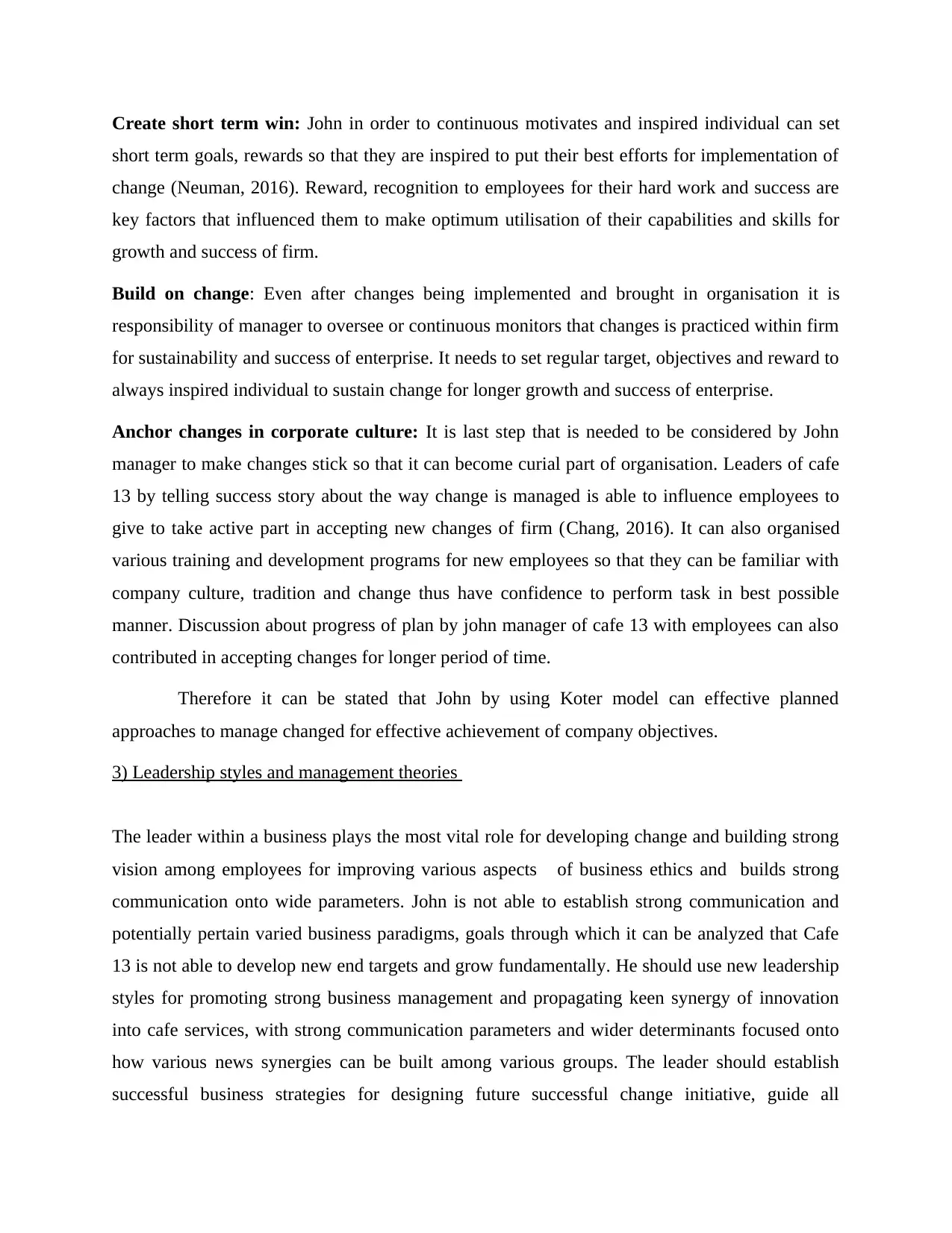
Create short term win: John in order to continuous motivates and inspired individual can set
short term goals, rewards so that they are inspired to put their best efforts for implementation of
change (Neuman, 2016). Reward, recognition to employees for their hard work and success are
key factors that influenced them to make optimum utilisation of their capabilities and skills for
growth and success of firm.
Build on change: Even after changes being implemented and brought in organisation it is
responsibility of manager to oversee or continuous monitors that changes is practiced within firm
for sustainability and success of enterprise. It needs to set regular target, objectives and reward to
always inspired individual to sustain change for longer growth and success of enterprise.
Anchor changes in corporate culture: It is last step that is needed to be considered by John
manager to make changes stick so that it can become curial part of organisation. Leaders of cafe
13 by telling success story about the way change is managed is able to influence employees to
give to take active part in accepting new changes of firm (Chang, 2016). It can also organised
various training and development programs for new employees so that they can be familiar with
company culture, tradition and change thus have confidence to perform task in best possible
manner. Discussion about progress of plan by john manager of cafe 13 with employees can also
contributed in accepting changes for longer period of time.
Therefore it can be stated that John by using Koter model can effective planned
approaches to manage changed for effective achievement of company objectives.
3) Leadership styles and management theories
The leader within a business plays the most vital role for developing change and building strong
vision among employees for improving various aspects of business ethics and builds strong
communication onto wide parameters. John is not able to establish strong communication and
potentially pertain varied business paradigms, goals through which it can be analyzed that Cafe
13 is not able to develop new end targets and grow fundamentally. He should use new leadership
styles for promoting strong business management and propagating keen synergy of innovation
into cafe services, with strong communication parameters and wider determinants focused onto
how various news synergies can be built among various groups. The leader should establish
successful business strategies for designing future successful change initiative, guide all
short term goals, rewards so that they are inspired to put their best efforts for implementation of
change (Neuman, 2016). Reward, recognition to employees for their hard work and success are
key factors that influenced them to make optimum utilisation of their capabilities and skills for
growth and success of firm.
Build on change: Even after changes being implemented and brought in organisation it is
responsibility of manager to oversee or continuous monitors that changes is practiced within firm
for sustainability and success of enterprise. It needs to set regular target, objectives and reward to
always inspired individual to sustain change for longer growth and success of enterprise.
Anchor changes in corporate culture: It is last step that is needed to be considered by John
manager to make changes stick so that it can become curial part of organisation. Leaders of cafe
13 by telling success story about the way change is managed is able to influence employees to
give to take active part in accepting new changes of firm (Chang, 2016). It can also organised
various training and development programs for new employees so that they can be familiar with
company culture, tradition and change thus have confidence to perform task in best possible
manner. Discussion about progress of plan by john manager of cafe 13 with employees can also
contributed in accepting changes for longer period of time.
Therefore it can be stated that John by using Koter model can effective planned
approaches to manage changed for effective achievement of company objectives.
3) Leadership styles and management theories
The leader within a business plays the most vital role for developing change and building strong
vision among employees for improving various aspects of business ethics and builds strong
communication onto wide parameters. John is not able to establish strong communication and
potentially pertain varied business paradigms, goals through which it can be analyzed that Cafe
13 is not able to develop new end targets and grow fundamentally. He should use new leadership
styles for promoting strong business management and propagating keen synergy of innovation
into cafe services, with strong communication parameters and wider determinants focused onto
how various news synergies can be built among various groups. The leader should establish
successful business strategies for designing future successful change initiative, guide all
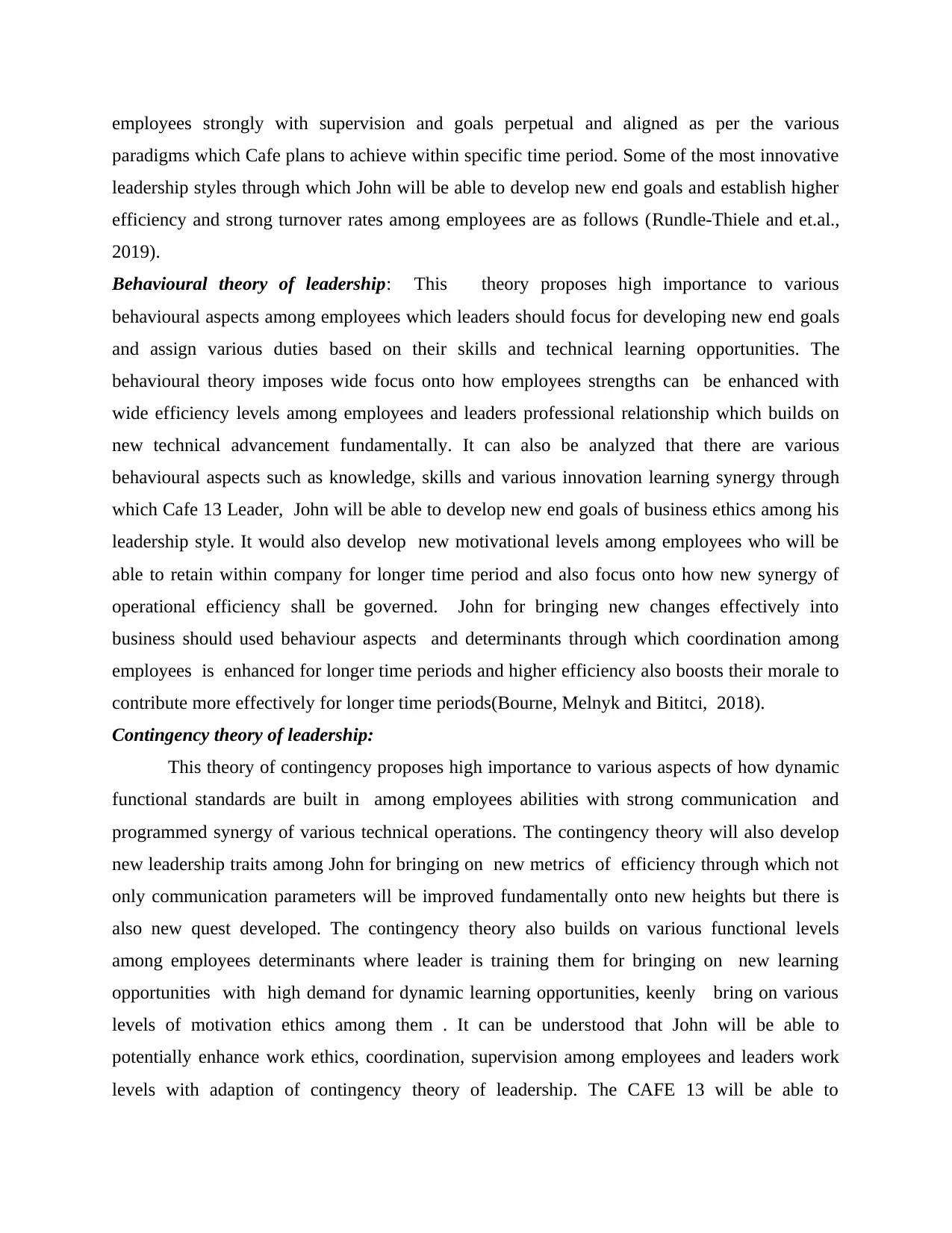
employees strongly with supervision and goals perpetual and aligned as per the various
paradigms which Cafe plans to achieve within specific time period. Some of the most innovative
leadership styles through which John will be able to develop new end goals and establish higher
efficiency and strong turnover rates among employees are as follows (Rundle-Thiele and et.al.,
2019).
Behavioural theory of leadership: This theory proposes high importance to various
behavioural aspects among employees which leaders should focus for developing new end goals
and assign various duties based on their skills and technical learning opportunities. The
behavioural theory imposes wide focus onto how employees strengths can be enhanced with
wide efficiency levels among employees and leaders professional relationship which builds on
new technical advancement fundamentally. It can also be analyzed that there are various
behavioural aspects such as knowledge, skills and various innovation learning synergy through
which Cafe 13 Leader, John will be able to develop new end goals of business ethics among his
leadership style. It would also develop new motivational levels among employees who will be
able to retain within company for longer time period and also focus onto how new synergy of
operational efficiency shall be governed. John for bringing new changes effectively into
business should used behaviour aspects and determinants through which coordination among
employees is enhanced for longer time periods and higher efficiency also boosts their morale to
contribute more effectively for longer time periods(Bourne, Melnyk and Bititci, 2018).
Contingency theory of leadership:
This theory of contingency proposes high importance to various aspects of how dynamic
functional standards are built in among employees abilities with strong communication and
programmed synergy of various technical operations. The contingency theory will also develop
new leadership traits among John for bringing on new metrics of efficiency through which not
only communication parameters will be improved fundamentally onto new heights but there is
also new quest developed. The contingency theory also builds on various functional levels
among employees determinants where leader is training them for bringing on new learning
opportunities with high demand for dynamic learning opportunities, keenly bring on various
levels of motivation ethics among them . It can be understood that John will be able to
potentially enhance work ethics, coordination, supervision among employees and leaders work
levels with adaption of contingency theory of leadership. The CAFE 13 will be able to
paradigms which Cafe plans to achieve within specific time period. Some of the most innovative
leadership styles through which John will be able to develop new end goals and establish higher
efficiency and strong turnover rates among employees are as follows (Rundle-Thiele and et.al.,
2019).
Behavioural theory of leadership: This theory proposes high importance to various
behavioural aspects among employees which leaders should focus for developing new end goals
and assign various duties based on their skills and technical learning opportunities. The
behavioural theory imposes wide focus onto how employees strengths can be enhanced with
wide efficiency levels among employees and leaders professional relationship which builds on
new technical advancement fundamentally. It can also be analyzed that there are various
behavioural aspects such as knowledge, skills and various innovation learning synergy through
which Cafe 13 Leader, John will be able to develop new end goals of business ethics among his
leadership style. It would also develop new motivational levels among employees who will be
able to retain within company for longer time period and also focus onto how new synergy of
operational efficiency shall be governed. John for bringing new changes effectively into
business should used behaviour aspects and determinants through which coordination among
employees is enhanced for longer time periods and higher efficiency also boosts their morale to
contribute more effectively for longer time periods(Bourne, Melnyk and Bititci, 2018).
Contingency theory of leadership:
This theory of contingency proposes high importance to various aspects of how dynamic
functional standards are built in among employees abilities with strong communication and
programmed synergy of various technical operations. The contingency theory will also develop
new leadership traits among John for bringing on new metrics of efficiency through which not
only communication parameters will be improved fundamentally onto new heights but there is
also new quest developed. The contingency theory also builds on various functional levels
among employees determinants where leader is training them for bringing on new learning
opportunities with high demand for dynamic learning opportunities, keenly bring on various
levels of motivation ethics among them . It can be understood that John will be able to
potentially enhance work ethics, coordination, supervision among employees and leaders work
levels with adaption of contingency theory of leadership. The CAFE 13 will be able to
⊘ This is a preview!⊘
Do you want full access?
Subscribe today to unlock all pages.

Trusted by 1+ million students worldwide
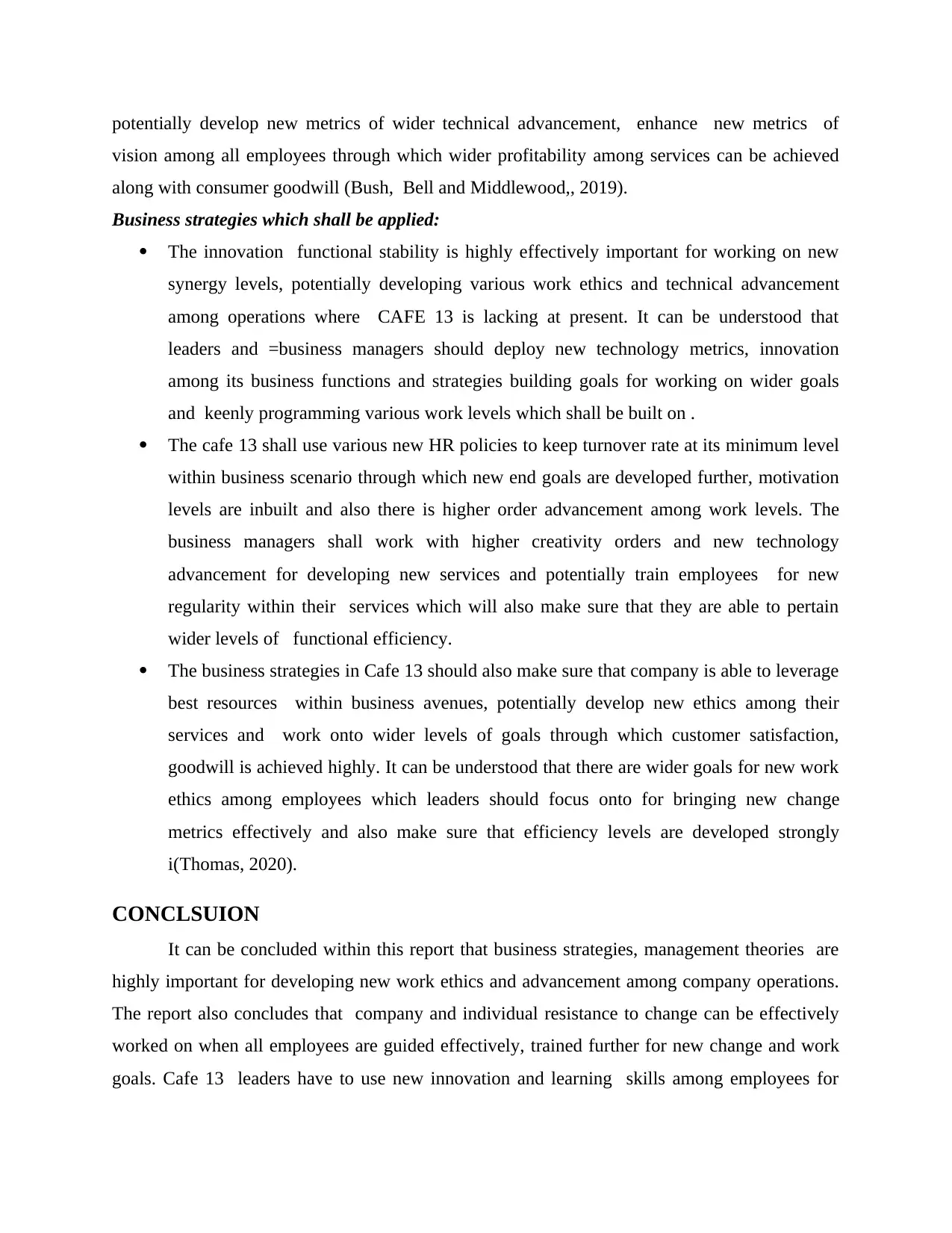
potentially develop new metrics of wider technical advancement, enhance new metrics of
vision among all employees through which wider profitability among services can be achieved
along with consumer goodwill (Bush, Bell and Middlewood,, 2019).
Business strategies which shall be applied:
The innovation functional stability is highly effectively important for working on new
synergy levels, potentially developing various work ethics and technical advancement
among operations where CAFE 13 is lacking at present. It can be understood that
leaders and =business managers should deploy new technology metrics, innovation
among its business functions and strategies building goals for working on wider goals
and keenly programming various work levels which shall be built on .
The cafe 13 shall use various new HR policies to keep turnover rate at its minimum level
within business scenario through which new end goals are developed further, motivation
levels are inbuilt and also there is higher order advancement among work levels. The
business managers shall work with higher creativity orders and new technology
advancement for developing new services and potentially train employees for new
regularity within their services which will also make sure that they are able to pertain
wider levels of functional efficiency.
The business strategies in Cafe 13 should also make sure that company is able to leverage
best resources within business avenues, potentially develop new ethics among their
services and work onto wider levels of goals through which customer satisfaction,
goodwill is achieved highly. It can be understood that there are wider goals for new work
ethics among employees which leaders should focus onto for bringing new change
metrics effectively and also make sure that efficiency levels are developed strongly
i(Thomas, 2020).
CONCLSUION
It can be concluded within this report that business strategies, management theories are
highly important for developing new work ethics and advancement among company operations.
The report also concludes that company and individual resistance to change can be effectively
worked on when all employees are guided effectively, trained further for new change and work
goals. Cafe 13 leaders have to use new innovation and learning skills among employees for
vision among all employees through which wider profitability among services can be achieved
along with consumer goodwill (Bush, Bell and Middlewood,, 2019).
Business strategies which shall be applied:
The innovation functional stability is highly effectively important for working on new
synergy levels, potentially developing various work ethics and technical advancement
among operations where CAFE 13 is lacking at present. It can be understood that
leaders and =business managers should deploy new technology metrics, innovation
among its business functions and strategies building goals for working on wider goals
and keenly programming various work levels which shall be built on .
The cafe 13 shall use various new HR policies to keep turnover rate at its minimum level
within business scenario through which new end goals are developed further, motivation
levels are inbuilt and also there is higher order advancement among work levels. The
business managers shall work with higher creativity orders and new technology
advancement for developing new services and potentially train employees for new
regularity within their services which will also make sure that they are able to pertain
wider levels of functional efficiency.
The business strategies in Cafe 13 should also make sure that company is able to leverage
best resources within business avenues, potentially develop new ethics among their
services and work onto wider levels of goals through which customer satisfaction,
goodwill is achieved highly. It can be understood that there are wider goals for new work
ethics among employees which leaders should focus onto for bringing new change
metrics effectively and also make sure that efficiency levels are developed strongly
i(Thomas, 2020).
CONCLSUION
It can be concluded within this report that business strategies, management theories are
highly important for developing new work ethics and advancement among company operations.
The report also concludes that company and individual resistance to change can be effectively
worked on when all employees are guided effectively, trained further for new change and work
goals. Cafe 13 leaders have to use new innovation and learning skills among employees for
Paraphrase This Document
Need a fresh take? Get an instant paraphrase of this document with our AI Paraphraser
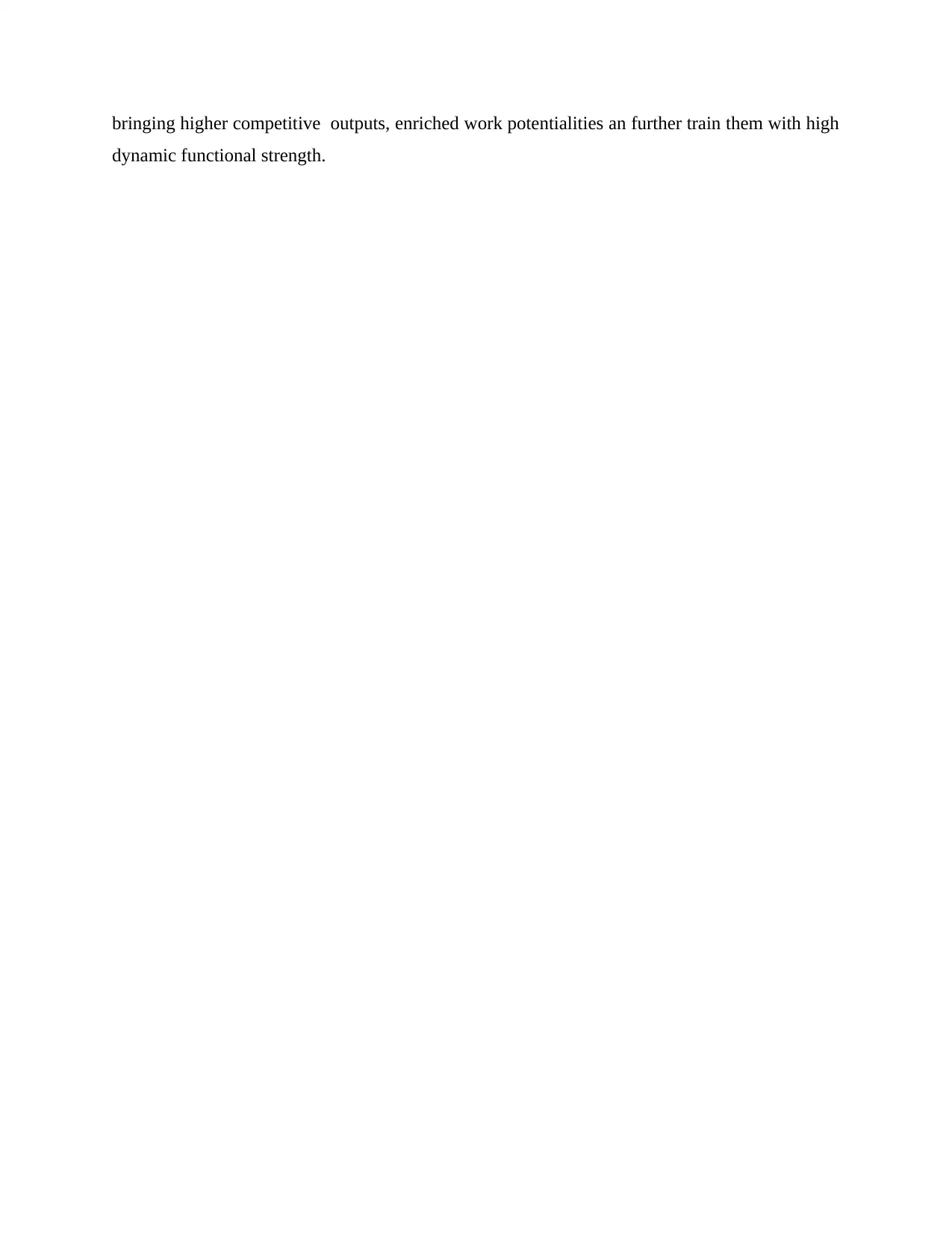
bringing higher competitive outputs, enriched work potentialities an further train them with high
dynamic functional strength.
dynamic functional strength.
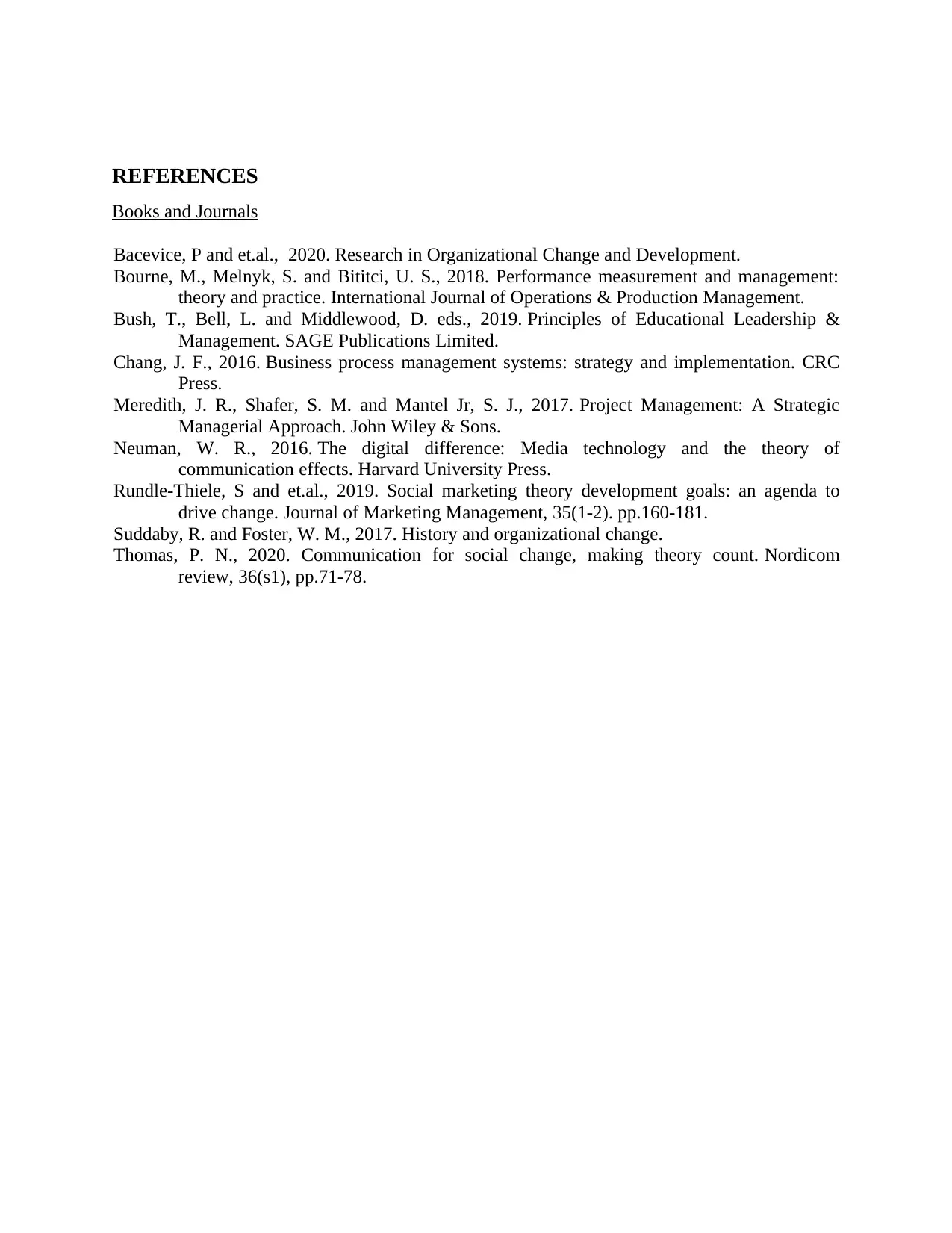
REFERENCES
Books and Journals
Bacevice, P and et.al., 2020. Research in Organizational Change and Development.
Bourne, M., Melnyk, S. and Bititci, U. S., 2018. Performance measurement and management:
theory and practice. International Journal of Operations & Production Management.
Bush, T., Bell, L. and Middlewood, D. eds., 2019. Principles of Educational Leadership &
Management. SAGE Publications Limited.
Chang, J. F., 2016. Business process management systems: strategy and implementation. CRC
Press.
Meredith, J. R., Shafer, S. M. and Mantel Jr, S. J., 2017. Project Management: A Strategic
Managerial Approach. John Wiley & Sons.
Neuman, W. R., 2016. The digital difference: Media technology and the theory of
communication effects. Harvard University Press.
Rundle-Thiele, S and et.al., 2019. Social marketing theory development goals: an agenda to
drive change. Journal of Marketing Management, 35(1-2). pp.160-181.
Suddaby, R. and Foster, W. M., 2017. History and organizational change.
Thomas, P. N., 2020. Communication for social change, making theory count. Nordicom
review, 36(s1), pp.71-78.
Books and Journals
Bacevice, P and et.al., 2020. Research in Organizational Change and Development.
Bourne, M., Melnyk, S. and Bititci, U. S., 2018. Performance measurement and management:
theory and practice. International Journal of Operations & Production Management.
Bush, T., Bell, L. and Middlewood, D. eds., 2019. Principles of Educational Leadership &
Management. SAGE Publications Limited.
Chang, J. F., 2016. Business process management systems: strategy and implementation. CRC
Press.
Meredith, J. R., Shafer, S. M. and Mantel Jr, S. J., 2017. Project Management: A Strategic
Managerial Approach. John Wiley & Sons.
Neuman, W. R., 2016. The digital difference: Media technology and the theory of
communication effects. Harvard University Press.
Rundle-Thiele, S and et.al., 2019. Social marketing theory development goals: an agenda to
drive change. Journal of Marketing Management, 35(1-2). pp.160-181.
Suddaby, R. and Foster, W. M., 2017. History and organizational change.
Thomas, P. N., 2020. Communication for social change, making theory count. Nordicom
review, 36(s1), pp.71-78.
⊘ This is a preview!⊘
Do you want full access?
Subscribe today to unlock all pages.

Trusted by 1+ million students worldwide
1 out of 9
Related Documents
Your All-in-One AI-Powered Toolkit for Academic Success.
+13062052269
info@desklib.com
Available 24*7 on WhatsApp / Email
![[object Object]](/_next/static/media/star-bottom.7253800d.svg)
Unlock your academic potential
Copyright © 2020–2025 A2Z Services. All Rights Reserved. Developed and managed by ZUCOL.





